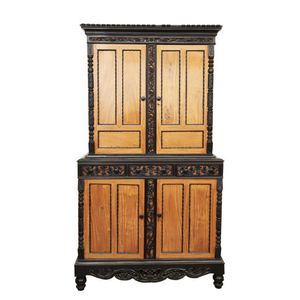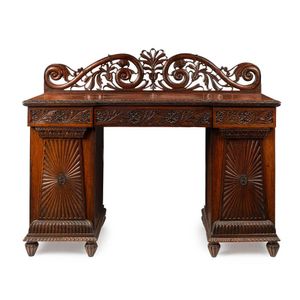
Antique Anglo-Indian Rosewood Double Ended Sofa
Anglo-Indian rosewood double ended sofa, c. 1830, the rectangular back surmounted by a double scrolled crest, over-scrolled arms carved with papyrus, beaded front rail, raised on lion paw feet, height 83 cm width 202 cm depth 71 cm

Anglo-Indian Teak Linen Press with Drawers and Slides
A 19th century Anglo Indian teak linen press the upper section with two sunburst panelled doors opening to three linen slides, the lower section with two short and two full length drawers, turned supports, 115.5 x 114.5 x 45 cm

19th Century Anglo-Indian Rosewood Sideboard
A finely carved Anglo-Indian rosewood sideboard, 19th century, 125 cm high, 168 cm wide, 62 cm deep

Carved Rosewood Settee with Foliage and Birds
Anglo Indian carved rosewood settee, circa 1870's, frame pierced and carved with Foliage fruit and birds upholstered seat Exhibited at and purchased from Melbourne international exhibition, 1880, height 94 cm, width 173 cm

Anglo-Indian Ebony Pier Cabinets with Marble Tops
A pair of fine Anglo-Indian pier cabinets, ebony and carved gilt-wood with marble tops, 18th/19th century, 103 cm high, 91 cm wide, 49 cm deep

Carved Padouk Dutch Bureau-Bookcase, 18th/19th Century
A richly carved padouk bureau-bookcase, Dutch, 18th/19th century, 250 cm high, 136 cm wide, 53 cm deep

Regency Cast Iron Greek Revival Bench with Carved Inset Timber
Indian Regency period cast iron Greek revival four-seat bench, raised on paw feet below tapered stem with vase arm support, the frame inset with carved and caned timber sections. Circa 1820, 214 x 100 x 53 cm. Provenance: The Gaekwad Maharajas of Baroda.…

Elaborate Anglo-Indian Secretaire Desk, 1880
A profusely carved Anglo-indian secretaire desk, circa 1880. 135 cm high, 120 cm wide, 76 cm deep

Antique Anglo-Indian Carved Padouk Display Cabinet
Anglo-Indian museum display cabinet, finely carved padouk circa 1850's.175 cm high, 152 cm wide, 68 cm deep

Lockwood de Forest's Carved Teak Vitrine
A late 19th century carved teak vitrine, designed by Lockwood de Forest II (1850-1932), made in Ahmedabad, India, assembled in New York, 167.5 x 81.4 x 30.8 cm. Provenance: From the collection of Lockwood de Forest II (1850-1932) and by descent to the…

Anglo-Indian Satinwood & Ebonised Cabinet with Carved Columns
Anglo Indian satinwood and ebonised cabinet, Sri Lanka, the moulded cornice above a pair of doors flanked by carved columns, over a three drawer frieze with applied and open carved detail, the base with a pair of cupboard doors, raised on turned feet,…

George III Satinwood and Sabicu Bonheur-du-jour Cabinet
A George III satinwood and sabicu Bonheur-du-jour, attributed to George Simson, circa 1790, with finely figured West Indian satinwood and Caribbean Sabicu veneers and ebony stringing throughout, the superstructure with gallery top above an open bookshelf…

19th Century Anglo-Indian Ebonised Collectors Cabinet
An Anglo-Indian ebonised Collectors cabinet, 19th century, carved with flowering vine borders to each edge and side, the twin doors carved with mandalas, raised on squat bun feet, 99 cm high, 113 cm wide, 52 cm deep

Ornate Anglo-Indian Regency Sideboard, 1820
A fine Anglo-Indian Regency twin pedestal sideboard, ornately carved padouk, circa 1820, 125 cm high, 153 cm wide, 61 cm deep

19th Century Anglo Indian Ebony Four Poster Bed
An Anglo Indian ebony four poster bed; 19th century and later, the four elaborately turned and reeded uprights joined by a headboard with shaped cresting and spindle turned rail, and footboard with lattice panel; supporting a slightly arched canopy.…

An exceptional marquetry and parquetry inlaid mahogany breakfront library bookcase, English circa 1785. Provenance: Apter Fredericks, London, presumably acquired in mid 1980's or earlier as this bookcase is recorded in a Leonard Joel insurance valuation…
 Loading more...
Loading more...